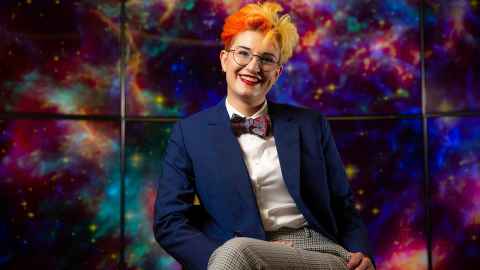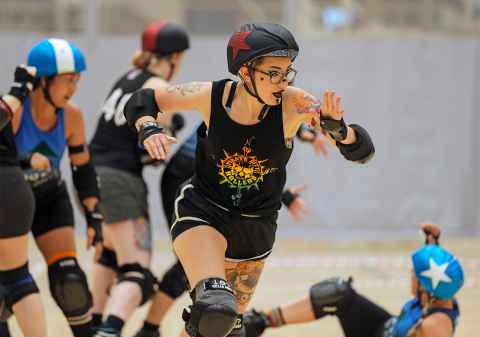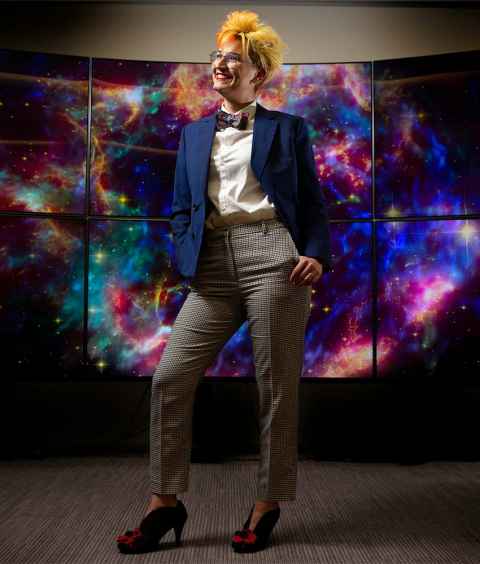Astrophysicist Heloise Stevance: space junkie on wheels
30 April 2021
Dr Heloise Stevance is a coder, gamer and an astrophysicist who’s smashing down gender stereotype walls, as well as smashing people in roller derby.

If the astronomy world was looking for a name for a new brightly coloured, effervescent supernova, they should look no further than ‘Heloise’.
Dr Heloise Stevance is a computational astronomer (more on what that involves later) but essentially she’s an astrophysicist brimming with excitement about her field of research.
When we meet, she bounces to the door barefoot, grinning, excited at the prospect of talking about astronomy and her favourite supernovae. One of them is in the background of the photo we take – it’s called Cassiopeia. Her other favourite is called the Crab.
“These are supernovae a few 100 to 1,000 years after they’ve exploded. You can see the star material that exploded … you see a flash of light,” she says enthusiastically. “Over time, that material spreads and you can take pictures of it with telescopes. The photo on the screen behind me was taken with multiple telescopes in space.
“The Crab was given its name when people only had those little telescopes. It has an actual pulsar and you can see that and a pinwheel formation in the middle. In x-ray images, it’s just beautiful! It looks fake, but it’s real. It’s just that the universe is so much more creative than we are.”
Heloise, pronounced with a silent H, is French but went to University in England before coming to New Zealand in 2019. She is one of a growing group of science communicators who explain their science in ways we can understand.
“I try to bring my science to people’s level and not expect them to meet me somewhere,” Heloise says. “I don’t like the term ‘dumbing it down’ because you’re not dumb just because you don’t have the same level of knowledge about this subject. You just haven’t spent as much time looking at it as I have.”
Heloise’s role in the Faculty of Science is 100 percent research but she does teach, mentor and gives talks to schools or groups either via Zoom or in person. “I have first and second-year students who get in touch and I make sure they’re okay. Otherwise, it’s honours students who work with me and my boss Jan ‘JJ’ Eldridge on specific research projects.”
She has also been contacted by teachers who see her on Twitter and book her to talk to classes. Twitter is also where she met her future boss.
“Jan had a position she was advertising. We’d also talked at a conference she’d done a few years back. When I finished my PhD, I was hired.”
Heloise tries to keep a lid on her social media interactions. “Science communication is just an aspect of my science, not a job I want to do on its own. Deep social media shenanigans aren’t great for my mental health so I’m happier to just work with real-life humans – live events with schools and stuff. On Twitter, not everyone is interested in what I have to say anyway.”
Heloise’s role is for three years. When she took it, she left behind a fiancé, also an astronomer, in the UK. The plan had been to rendezvous once every four to six months, through research trips or conferences. That plan has been eclipsed by the pandemic. It’s the only point in our conversation where Heloise is less than ecstatic.
“I just miss him so much and I miss simple things like just being on the couch with my husband, that’s what I call him. We were meant to get married in April 2020 but we’ve not seen each other for more than a year.
“Covid-19 has kicked our plans a little bit but it’s a rough time for everyone. We can’t make plans so may as well just ride the wave.” Fortunately, both have shared interests other than space. “We’re gamers so at least we can play games online together.”

Online gaming isn’t the only game she’s into.
“I started playing roller derby a few years ago – it’s a full-contact sport on wheely shoes! Like rugby, but you’re the ball.”
She trains at least a couple of times a week and plays in a competitive league.
“When I found out about it, it was like ‘this is a sport for me’. It’s so much fun skating and smashing into people. As it turns out, it’s a nice place for me to fit in, because I have always struggled with gender roles and my place within that. Roller derby is pretty much a queer environment so there is no judgement on me as a femme-presenting person.
“Sometimes the rest of the world is oppressive, but in roller derby you’re valued. You’re just hitting your friends hard, in a consensual way! It’s such a breath of fresh air.”
She says it’s the first time in her life she has been surrounded by a majority of women.
“I’ve always had more masculine tastes. For most of my life I’ve been surrounded by men, so being in a more diverse crowd is really interesting and opened my eyes to how gender roles really penetrate the workplace. The competitiveness is so very different with women and non-binary people. It’s more wholesome, in my experience, than in groups dominated by men.”
Despite the risk of injury, the sport actually helped heal Heloise.
“I was never a sporty person and roller derby is the first time I’ve enjoyed a sport. Running isn’t particularly fun but now I do a bit more just to keep fit for roller derby.
“What roller derby has done is help heal my relationship with my body. I had an eating disorder when I was younger until I was about 22. Growing up, there were tremendous issues in the representation of the ideal body type all around me. It’s still awful but at least it’s not images of literally dying skinny bodies in low-cut jeans.
“This sport has completely shifted my perspective. Instead of looking at my body for what it looked like, I look at it for what it can do. That was a huge mindset change. This is a physical activity I enjoy and can pride my body in.”

Science is hard. You’re pushing the boundaries of human knowledge and sometimes you just don’t know an answer. It’s a job where you’re always out of your depth. If you’re not, then you’re not doing it right.
She has also had issues of self-doubt that you could not possibly recognise were you to meet her in person, where she’s confident, eloquent and outspoken. She has been known to vent on Twitter, TikTok and in her blog, and has written some mainstream pieces for Newsroom.
One recently was in response to a widely published piece by astrophysicist Avi Loeb under various headings such as ‘Astronomer Avi Loeb Says Aliens Have Visited, and He’s Not Kidding’. She’s not afraid to take on the Harvard University professor for presenting his opinions on alien life as fact.
“I think he genuinely believes in what he says, but it’s still problematic behaviour for him to put that stuff out into the universe. When you’re part of an establishment like Harvard, your words have an incredible weight.
“People think you represent a certain part of science because you’re a scientist and you’ve got a title, and you’re putting your opinion out there. But he doesn’t represent even a fraction of scientists. It’s Avi versus everyone else. So it’s problematic for him to do that but it’s even more problematic for news editors. They should ask other scientists rather than run clickbait headings.
“Find me an astronomer who does not believe there is life somewhere else in the universe because statistically speaking there probably is. It’s just not going to be Avi’s little green men sending a spaceship to wander Earth.”
Heloise gets fired up on this subject and has also voiced her opinions on the way women scientists are treated.
“I wrote a piece in my blog titled, ‘You’re too pretty to be a physicist’. Those are the kinds of comments I’ve received that irk me.
“I came out of university with a masters in Physics and Astronomy with first-class honours, obtained a PhD by the time I was 26, I speak three languages, and I’m always there for my partner and my friends. My physical appearance does not add or take away value from who I am,” she wrote.
Despite her extraordinary brain and talent as an up-and-coming scientist, Heloise admits to feeling ‘imposter syndrome’.
“I suffer from it tremendously. It’s very common because science is hard. You’re pushing the boundaries of human knowledge, and sometimes you just don’t know an answer. It’s problem-solving and when you finally solve a problem, you move on to the next one.
“It’s a job where you’re always out of your depth. If you’re not, then you’re not doing it right.”
Despite this, she loves academia.
“I love interacting with students and it sounds weird but I’m better at telling people what to do, then I am doing it myself. Because of the imposter syndrome, in my head I’m saying ‘you can’t do this’. That can be paralysing and really slow me down. I’m much better at encouraging people and giving them the means to succeed.”
In turn, she finds students help her, sparking her curiosity on days when it’s low.
“If I have a meeting with a student who asks loads of questions, you feel helpful. It gives a sense of achievement. When your code is not working, it really helps.”
She says sitting by herself doing research eight hours a day, five days a week, can be lonely and isn’t effective for problem-solving. That’s where interaction with students and her colleagues is beneficial.
“They make me feel useful, and that improves my productivity.”
In education, you’re not rewarded for failure. Failure is bad. But the problem with coding is that you fail most of the time. About 80 percent of coding is debugging. I had to shift my mindset to become comfortable with that.

Coding is one of her strengths but it’s still a challenge.
“I was a terrible coder and really scared of it for a long time. But I probably got hired for this job because of my coding skills.
“Here’s the thing about coding. In education, you’re not rewarded for failure. Failure is bad. But the problem with coding is that you fail most of the time. Most of the time there’s a bug in your code and you have to fix it. About 80 percent of coding is debugging. It’s hard not to take it personally when the computer keeps screaming error.
“I had to shift my mindset to become comfortable with that and it’s something a lot of students struggle with too, so I can be good at helping them.”
Heloise says there was never a eureka moment that led to choosing astronomy but she always loved astronomy documentaries.
“I was interested in how stars work, how black holes work. I loved to hear about that over and over again.
“At school, I was very curious and I still am. When I went to England to study, there were subjects like chemistry, physics, astronomy. I was like, ‘oh my god, I can pick a degree in astronomy’.
Now she’s a computational astronomer.
“Traditionally there are two main categories of astronomers – observers and theorists. The theorists use physics and maths to predict what the universe should do; the observers take pictures and analyse them to see what the universe actually does. Sometimes they meet in the middle. I’m neither one nor the other and also a little bit of both.
"I used to be more of an observer, but now I don’t even take pictures. I take data from people who do it better than me. But there’s so much data out there, both in the models and from the telescopes, that bridging the gap between theory and observation is a full-time job.
“I bring observations and theory together using the power of modern technology, with modern statistical and computational skills.
“People don’t expect astronomers to code that much. People imagine us behind a telescope but I code most of the day, all day, every day. I just love finding things that I didn’t expect.”
When she’s out in social situations and is asked what she does for a job, her response can vary.
“I say astronomy or astrophysics but if I say astrophysics people are like ‘whoa’ because they don’t like physics. If I say astronomy, people usually find it cool. What irks me is that people usually say they are too dumb to do what I do – this comes from the idea that to be a scientist you have to be some kind of genius. Those stereotypes put unnecessary limits on people.”
That said, she’s limiting herself to Earth – she wouldn’t venture into space.
“I’d do the vomit comet, to experience zero-G, but space is a dangerous place.”
She’s happier on terra firma, such as in a roller derby game where she’s the one whose hair matches her skate wheels. “I picked my hair colour and then looked at my wheels and I was like, ‘wow I’m colour coordinated’.”
One of her masters students describes her as the “crazy but brilliant yellow-haired space lady”.
“He loves quoting stupid stuff I say. He was preparing a talk recently and told me he was going to quote me saying something like, ‘you could do it in principle, but it’s f***ing hard’.”
She laughs. And it’s effing hard not to laugh with her.
– Denise Montgomery
This article first appeared in the May 2021 edition of UniNews.
Republish with permission. Email: uninews@auckland.ac.nz